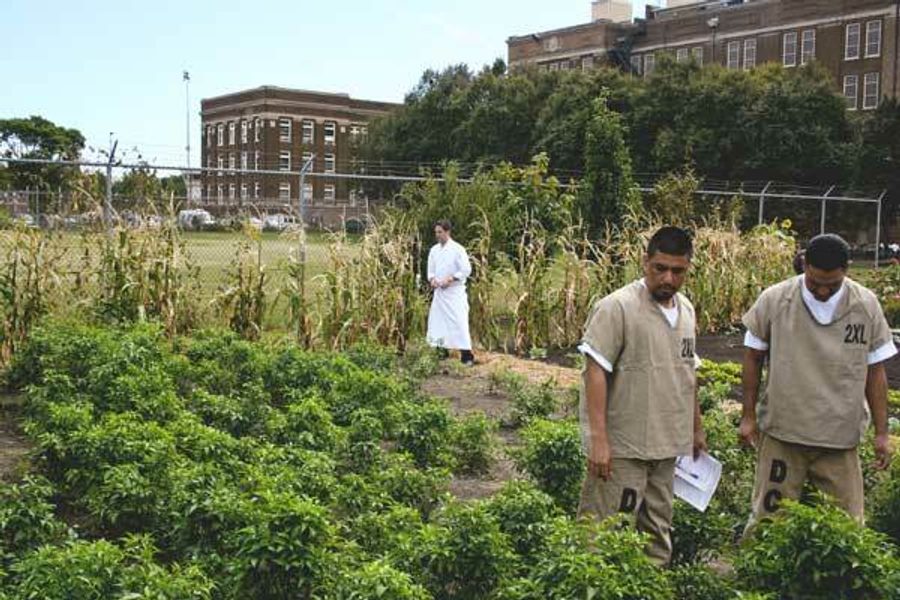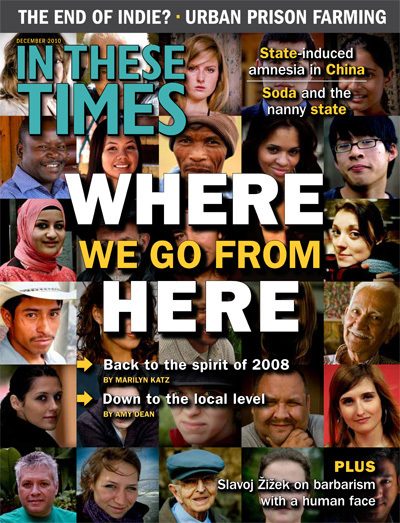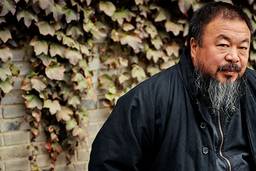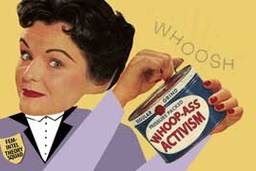‘Old Times There Are Not Forgotten’
Urban prison farming and the difference between reform and revolution.
Lisa Yun Lee

Consider this uncanny photograph of the thriving urban farm located behind razor barbed wire at the Cook County Jail in Chicago. It demands and resists interpretation. The image calls to mind, in a perturbing manner, the histories of slavery, plantation life and sharecropping. The Caucasian chef in the background dressed in classic “chef’s whites” and the two prisoners of color in the foreground are a visual representation and reminder of the appalling statistics that document the dramatic racial disparities between those people in the United States who are locked up and those who are not.
Yet we celebrate and embrace the idea of the urban farm. It seems to signify self-determination, local empowerment, sustainability and environmental justice. But without the specificity of site and the particular stories of the people who work on and are nourished by the land, an urban farm is but an abstraction, an empty concept.
The farm pictured above is a joint effort of the Cook County Sheriff’s Department of Community Supervision and Intervention and the University of Illinois Extension. The photograph was circulated as part of a public relations campaign prompted by the September graduation ceremony for prisoners in the program.
The food that is grown on the farm does not nourish the prisoners who – if they are good – are fed an insipid diet consisting mostly of oatmeal and bologna. If they are being disciplined, their punishment includes “controlled feeding,” during which they are served Nutraloaf, a thick orange lump of protein containing everything from carrots and cabbage to kidney bean and potatoes to “dairy blend” and “mechanically separated poultry.” This hodgepodge is puréed into a paste, shaped into a loaf and baked for 50 to 70 minutes at 375 degrees. Prisoners in Illinois have unsuccessfully tried to sue the state about this “controlled feeding” based on the 8th Amendment’s prohibition against cruel and unusual punishment.
The food that is harvested in this farm is donated to soup kitchens, homeless shelters and food pantries. Since the garden was started in 1993, 52 tons of fruits and vegetables have gone to others in need. Chef Charlie Trotter also purchases produce from the prison to serve at his restaurant. Last year, 225 pounds of tomatoes, cucumbers, peppers, cabbage and other vegetables from the garden were provided to his restaurant in Chicago, one of the most respected in the world.
The farm project suggests the purpose of imprisonment should be rehabilitation, rater than retribution or deterrence. Prisoners who tend to the 13,000 square foot plot are all nonviolent offenders who are going through a substance abuse treatment program. They take a course to learn the necessary skills, work 60 hours in the farm and earn a Master Gardener certificate. Prison officials justifiably boast that while the national recidivism rate is about 54 percent, the rate of prisoners graduating from the garden program is 17 percent. Former prisoners that I spoke with, who have cultivated gardens while behind bars, support the program and preferred working outside tending and nurturing vegetables and plants to their other options.
So what is the problem? Why shouldn’t we embrace this project as progress? The image above allows us to pause and question what we should be advocating for.
According to the Pew Center’s “Prison Count 2010,” the United States continues to lead the world in incarceration with more than 2.1 million people incarcerated in federal, state and local prisons. In 20 states, the percent of blacks incarcerated is at least five times greater than their share of resident population. Scholars Angela Davis and Ruth Wilson Gilmore have pointed out that the growth of prisons is a result of inadequate or absent social welfare programs following the end of slavery. Abolition may have succeeded in redefining the law, but it failed to develop alternative, democratic structures for racial equality.
Yusef Shakur, the activist educator and author of the prison memoir The Window 2 My Soul: My Transformation from a Zone 8 Thug to a Father & Freedom Fighter, A Political Memoir, explained to me what it like to work in a prison garden. “This is a unique shit-uation,” he wrote. The gardens he cultivated with others constituted “a life changing moment, as they transform the land it teaches them the opportunity of how they can transform themselves.” However, he also went on to acknowledge: “At the end of the day whatever we do with the enemy culture will feel like a huge contradiction. … The harsh reality is that prisons/county jails are nothing but modern day slave plantations.”
One often hears of the dichotomy between reform and revolution. Some say the incremental changes advocated by reformers are ineffective and perhaps in the long term even detrimental to social transformation. I am convinced that the opposite is true.
Caring for our families and ourselves – as we live within our culture and unleash our radical imagination – acknowledges that social change is part of the unfolding of history and not merely a series of isolated moments. Efforts to change society have always included attending to people’s needs while insisting on radically new polices and fundamental changes to institutional structures.
One example of this is the Free Breakfast Program that the Black Panthers began operating in Oakland in 1969. Under the philosophy of “survival pending revolution,” this visionary movement fed people’s insistent hunger, not just for nourishment, but also for peace and justice. The Panthers set up kitchens in cities across the nation, feeding more than 10,000 hungry children every day before they went to school. By doing so they shamed and inspired the government to model a program offering breakfast in public schools across the country.
Encouraging reforms within jails and prisons to make life there more humane should not be excluded from our efforts to transform the world into a more just place. We should not let piecemeal reforms make the prison-industrial complex literally and figuratively “more palatable” to us.
The prison photograph also exposes a conundrum for urban farming activists and enthusiasts – of which I count myself – who have embraced the taking over of city spaces for food production. While this “delicious revolution” addresses the critically important issues of how we grow, distribute and eat food, it fails to provide a critique of the awful reality of urban decay, joblessness and the history of racism.
Food deserts – areas of exclusion where people experience physical and economic barriers to accessing healthy food – and the vacant lots that are ingeniously being used by urban farmers to provide for surrounding communities, are symptoms of society’s abandonment of citizens who live in a huge track of cities throughout the United States. Therefore our gritty efforts to turn the detritus of racism and laissez-faire capitalism into healthier soil for food production are necessary, but insufficient. While we plant and cultivate city spaces in order to survive, we must simultaneously understand and analyze why there is such gross inequity in certain neighborhoods and not in others.
The photo of the prison farm calls on us to expand the horizon of our imaginations. In order to implement the reforms we need to survive and to create the radical change we need to thrive, we must think and dream in new ways about what we are against and – most importantly – what we are for.








